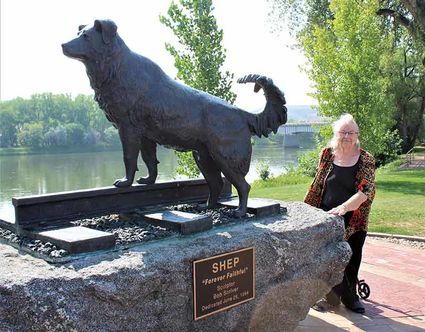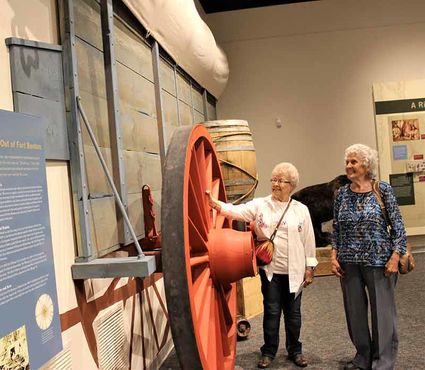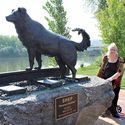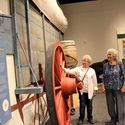16 Local seniors make day long trip to "Birthplace of Montana™"
August 22, 2018

Elaine Campbell stands at the memorial to Shep, a ranch dog who waited nearly six years at the Fort Benton train depot for his deceased master to return. Campbell recalled riding on the train with her family in the early 1940's and hearing the conductor tell the story of Shep. The conductor then pointed out the dog at the station. Shep was killed by a train in 1942.
Sixteen seniors from Blaine County recently spent a day in Fort Benton, the town known as the "Birthplace of Montana™."
The day-long bus trip was organized through the Chinook Senior Center and was open to any adult in the county. Based on the positive response to the trip, organizers are hopeful future outings to places of interest in the region can be arranged.
The charge for the trip included the cost of the bus trip, lunch at Fort Benton's Golden (Senior) Center and admission to two museums in the historic town.
Bureau of Land Management's Missouri Breaks National Monument Interpretive Center
The group's first stop was the BLM's interpretive center, completed about a decade ago. Located southwest of downtown along the Missouri River, the building was designed to represent the famous White Cliffs section of the river. The center highlights the natural and cultural history of the Missouri River Breaks along the river.
A 20-minute video called "White Cliffs, Wild River" shows both the natural beauty and the history of this special area. Impressive photos of the flora and fauna of the area give the viewer an armchair view of the beauty of the breaks. Interspersed are scenes showing the history of the indigenous peoples in the area and the eventual settlement by homesteaders. Along one wall of the room where the movie was shown is a 3-D model of the Missouri River and the areas immediately adjacent. Several ranches and locales familiar to Blaine County residents are highlighted on the model of the river.
In the main exhibit area of the interpretive center are displays of wildlife native to the breaks, some historical information about how and why Fort Benton was so important to the settlement of the region and interactive displays, like the pilot house of a river steamboat, that allow visitors to be in the middle of the action.
An especially impressive exhibit shows the various trails from Fort Benton used to freight as far west as Walla Walla, Washington and north into Canada. A mock-up of the wheels and body of a Murphy freight wagon helps viewers understand how large pieces of freight could be shipped to Fort Benton by river boat, then off loaded into the freight wagons pulled by several teams of oxen. The freight wagons were so large and moved at such a slow pace the drivers, 'the bullwhackers,' walked along side the wagons to direct the oxen pulling the loads. In the Ag Museum, at another location, a mural-sized painting depicts a set of Murphy wagons, complete with oxen and bullwhackers, leaving Fort Benton with a load of freight.
A walk along Front Street in downtown Fort Benton and lunch with local seniors
Plans were made for the seniors to have lunch downtown at the Fort Benton senior center. Travelers were able to spend about an hour before lunch walking along Front Street that follows the river through downtown. Anchored at one end by the Lewis and Clark Memorial and mock-up of one of their river boats, the Mandan, the riverside walk extends to the old Union Hotel at the west end of town. In between is the iron bridge and historical information about the role of Fort Benton in the frontier west.
Perhaps symbolic of the railroad's role in taking over the movement of freight and passengers to and from the Fort Benton area, at the west end of the walk is a memorial to Shep, a local ranch dog. When Shep's owner died, the rancher's remains were shipped by train to a burial site away from Fort Benton. Shep followed the casket to the train station, then never left the station, waiting for his owner to return.
Shep kept a six year vigil. Old and nearly blind, he stepped into the path of a train entering the station and was killed in 1942. Shep's burial was a major news event with dignitaries from around the state attending a special ceremony for the dog. Local Scouts acted as pall bearers carrying Shep to his final resting place atop a hill east of town.
Elaine Campbell, one of the local seniors visiting the memorial, told, "In the early 1940's my family was riding the train to visit my grandparents in Whitefish. I remember the train's conductor telling us the story of Shep. Then the conductor pointed out the window and there was Shep, still waiting for his master."
The folks at the Fort Benton Senior Center were great hosts. After a delicious lunch of roast beef followed by pecan pie, I asked one of the ladies eating at our table, "Do you always eat this well?" She answered, "No, it's because you folks are visiting. Normally we just have hot dogs." Then she laughed.
A visit to the Museum of the Northern Great Plains (also known as the Montana Agricultural Museum)
The last stop for the touring Blaine Countians was the Museum of the Northern Great Plains. I'd been told what an interesting place it was but one really has to experience the museum to appreciate the variety and size of its historical collection. Out tour guide, Patty Paulsen who lives in Fort Benton but grew up in rural Chinook, explained that most of the exhibits were designed and built by locals and items in the collection came from homes, businesses, farms and ranches in Chouteau County.
In 1986 a building once used to manufacture duckfoot shovels (a type of cultivating device for tool bars) became available. A local entrepreneur started Gysler Manufacturing and later sold to Melroe who closed the facility. The River and Plains Society, a group of Chouteau Countians, bought the building and began developing a first class historical collection related to the area around the county.
A centerpiece when visitors enter the museum is the six plains bison that comprise the Hornaday collection. In 1886 zoologist-conservationist William Temple Hornaday collected the six bison from among the last remaining bison between the Missouri and Yellowstone Rivers. The six bison were displayed in the Smithsonian from 1888 to 1957, when they were dispersed to various locations. In the early 1990's the River and Plains Society undertook the project to find, restore and place the buffalo back on display in the museum in Fort Benton.
"Sandy," the bull in the group, was first used as the model for the buffalo nickel, originally introduced in 1913. Hornaday's big bull was also featured on a Lewis and Clark commemorative ten dollar bill issued in 1901. Affectionately known as the "bull bill," the bill had a picture of the bull bison in the center with an etching each of Lewis and Clark beside the bull. Several postage stamps also featured the likeness of "Sandy" over the years.
But there's a lot more than the bison to see at the museum. There's an amazing collection of farm equipment from the early days to the more modern-most manufactured but a lot of "one of a kind" inventions created by farmers and ranchers. Even the households are included, with interesting displays showing the history of devices from washing machines to telephones.
Outside visitors can walk through the Homestead Village to get an idea of life in the 1900's in the region. Guide Patty Paulsen said most of the buildings, ranging from a country church to a sheriff's office and jail, came from the region. All were restored by locals and donated items added for authenticity.
Ice cream social and goodbye to Fort Benton
The senior center had previously scheduled an ice cream social as a fundraiser. The Blaine County visitors regrouped at the center to enjoy some ice cream before the trip back home. It was a great day and even those who had visited the "birthplace of Montana" before agreed they had learned some new information about this important historical town.

Catherine Morgan and Elsie Bertelsen pose beside a mock up of a Murphy freight wagon. The gigantic wagons were used to haul freight off loaded from river steamships that landed at Fort Benton. Pulled by several teams of oxen, the wagons hauled freight to the region as well as north to Canada and west to Walla Walla, Washington
To learn about the museums operated by the River and Plains Society, go to: fortbentonmuseums.com. Check the museums' open dates and hours as they change by season. For info about the BLM's Interpretive Center, search 'Missouri Breaks Interpretive Center.' During the summer there is a Visitors' Center next to the access to the steel bridge in the center of town on Front Street. The folks working there are very helpful with information about all the attractions in Fort Benton.





